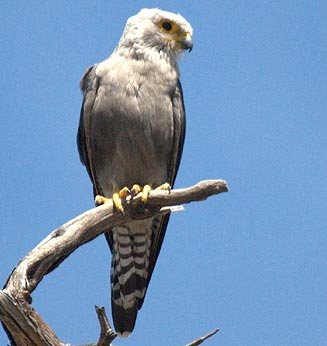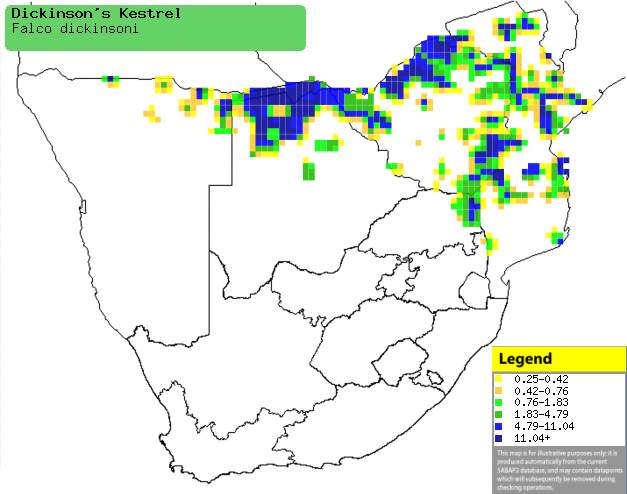|
Falco dickinsoni (Dickinson's
kestrel)
Dickinsonse grysvalk [Afrikaans]; Tuyu (also applied to
Black-shouldered kite) [Kwangali]; Dickinson-torenvalk [Dutch]; Faucon de
Dickinson [French]; SchwarzrŁckenfalke [German]; Falc„o de Dickinson
[Portuguese]
Life
> Eukaryotes >
Opisthokonta
> Metazoa (animals) >
Bilateria >
Deuterostomia > Chordata >
Craniata > Vertebrata (vertebrates) > Gnathostomata (jawed
vertebrates) > Teleostomi (teleost fish) > Osteichthyes (bony fish) > Class:
Sarcopterygii (lobe-finned
fish) > Stegocephalia (terrestrial
vertebrates) > Tetrapoda
(four-legged vertebrates) > Reptiliomorpha > Amniota >
Reptilia (reptiles) >
Romeriida > Diapsida > Archosauromorpha > Archosauria >
Dinosauria
(dinosaurs) > Saurischia > Theropoda (bipedal predatory dinosaurs) >
Coelurosauria > Maniraptora > Aves
(birds) > Order: Falconiformes >
Family: Falconidae
 |
|
|
Dickinson's Kestrel, Botswana. [photo
Bob Lewis
©] |
|
Distribution and habitat
Occurs from Angola, southern DRC, Tanzania and Zambia south
to southern Africa. Within southern Africa it is uncommon in Mozambique, Zimbabwe, northern
Botswana and the Caprivi Strip (Namibia), marginally extending to the Limpopo
Province and northern Namibia. It generally prefers low-lying tropical savanna,
especially with flood plains containing Hyphaene and Borassus
palms, as well as open Mopane (Colosphermum mopane) and miombo (Brachystegia)
woodland.
|
 |
|
Distribution of Dickinson's kestrel in southern
Africa, based on statistical smoothing of the records from first SA Bird
Atlas Project (©
Animal Demography unit, University of
Cape Town; smoothing by Birgit Erni and Francesca Little). Colours range
from dark blue (most common) through to yellow (least common).
See here for the latest distribution
from the SABAP2. |
Movements and migrations
Resident.
Food
It mainly eats insects, frogs, birds, snakes, small mammals
and crabs, usually hunting from a high perch (such as a dead tree) from which it
swoops down to prey in an open area. It also hawks prey aerially and is quite
opportunistic, catching animals fleeing from fires and following ploughs, so that
it can surprise exposed insects and rodents. The following food items have been recorded
in its diet:
- Invertebrates
- crabs
- insects, especially grasshoppers and crickets (Orthoptera)
- Vertebrates
- birds
- frogs
- snakes
- small mammals (including bats)
Breeding
- Monogamous, territorial solitary nester, although in Zambia nests can be
spaced as close as 275 metres apart.
- The nest is usually a cavity or hollow near the top of a palm, baobab or
other tree at least seven metres above ground. It may also use an old or
even an occupied Hamerkop nest, or rarely a cavity in a man-made structure.
- Egg-laying season is probably from late September to late October,
although this range is based on few records.
- It lays 1-5 eggs, which are mainly incubated by the female for about
30-32 days, while the male delivers food to her.
- The chicks are mainly fed by the male every 2-5 hours or so, while the
female tends and defends the nest, although she occasionally joins the
male hunting. The young leave the nest at about 30 days old, and are probably
able to fly about five days later.
Threats
Not threatened.
References
-
Hockey PAR, Dean WRJ and Ryan PG 2005. Roberts
- Birds of southern Africa, VIIth ed. The Trustees of the John Voelcker
Bird Book Fund, Cape Town.
|
